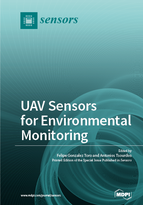UAV Sensors for Environmental Monitoring
A special issue of Sensors (ISSN 1424-8220).
Deadline for manuscript submissions: closed (15 September 2015) | Viewed by 331487
Special Issue Editors
Interests: remote sensing; UAV; unmanned aerial systems (UAS); bioinspired optimisation; multidisciplinary design optimisation; optimisation; drones; wildlife monitoring; precision agriculture
Special Issues, Collections and Topics in MDPI journals
Interests: unmanned aircraft systems; decision making on multi-agent systems; data-centric guidance and control; swarm
Special Issues, Collections and Topics in MDPI journals
Special Issue Information
Dear Colleagues,
The rapid development and growth of UAVs as a remote sensing platform as well as advances in the miniaturization of instrumentation and data systems are catalyzing a renaissance in remote sensing in a variety of fields and disciplines from precision agriculture to ecology, atmospheric research, and disaster response.
This Special Issue is seeking submissions that highlight advances in the development and use of sensors deployed on UAVs. Topics include, but are not limited, to:
- Optical, multi-spectral, hyperspectral, laser, and optical SAR technologies
- Gas analyzers and sensors
- Artificial intelligence and data mining based strategies from UAVs
- UAV onboard data storage, transmission, and retrieval
- Collaborative strategies and mechanisms to control multiple UAVs and sensor networks
- UAV sensor applications: precision agriculture; pest detection, forestry, mammal species tracking search and rescue; target tracking, the monitoring of the atmosphere; chemical, biological, and natural disaster phenomena; fire prevention, flood prevention; volcanic monitoring, pollution monitoring, micro-climates and land use
Dr. Felipe Gonzalez Toro
Guest Editor
Prof. Dr. Antonios Tsourdos
Co-Guest Editor
Manuscript Submission Information
Manuscripts should be submitted online at www.mdpi.com by registering and logging in to this website. Once you are registered, click here to go to the submission form. Manuscripts can be submitted until the deadline. All submissions that pass pre-check are peer-reviewed. Accepted papers will be published continuously in the journal (as soon as accepted) and will be listed together on the special issue website. Research articles, review articles as well as short communications are invited. For planned papers, a title and short abstract (about 100 words) can be sent to the Editorial Office for announcement on this website.
Submitted manuscripts should not have been published previously, nor be under consideration for publication elsewhere (except conference proceedings papers). All manuscripts are thoroughly refereed through a single-blind peer-review process. A guide for authors and other relevant information for submission of manuscripts is available on the Instructions for Authors page. Sensors is an international peer-reviewed open access semimonthly journal published by MDPI.
Please visit the Instructions for Authors page before submitting a manuscript. The Article Processing Charge (APC) for publication in this open access journal is 2600 CHF (Swiss Francs). Submitted papers should be well formatted and use good English. Authors may use MDPI's English editing service prior to publication or during author revisions.








